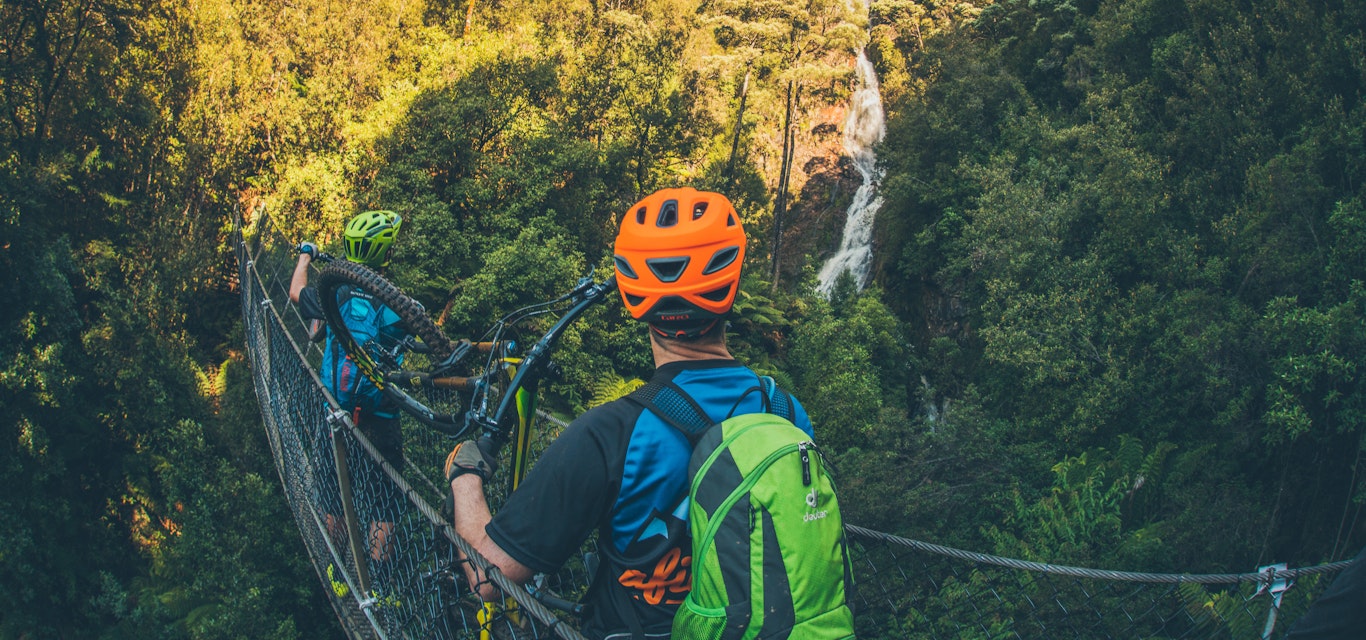Ride the rail trails
Tasmania’s cycling reputation is forged in mountain-bike trails, but off-road riding here doesn’t have to be all about berms, boulders and blacks.
Providing a gentle counterpoint to the mountain-biking bravado of Derby and Maydena is a neat collection of Tasmanian rail trails. These rides follow the course of abandoned railways and tramways, meaning they are almost entirely away from roads, but are also trails of gentle inclines and declines, with trains having been as reluctant as many cyclists to tackle steep climbs.
Rail trails have bloomed across the world in the past couple of decades. New Zealand’s reputation as a world-class cycling destination was founded on trails such as the Otago Central Rail Trail, while Victoria has more than 40 rail trails etched across the state.
With less fanfare, Tasmania has acquired its own compilation of rail trails, offering some wonderfully peaceful cycling steered by history.
Montezuma Falls
Tasmania’s tallest waterfall doubles as one of the state’s listed 60 Great Short Walks, but it’s not a place that’s exclusive to walkers. Cyclists, too, have a couple of ways of getting to the base of the 104m-high waterfall, including the main trail – the Great Short Walk – along the route of the former North East Dundas Tramway, which once transported material from mines near the falls to smelters in Zeehan.
The 10km return trail passes an evocative tramway timber bridge, rattling across old sleepers still embedded in the earth and passing the entrance to a mineshaft as it nears the waterfall. Park up at the trail’s end and walk the few steps to the base of the waterfall, and head out onto the high suspension bridge straddling the stream below the falls for a loftier perspective.
Credit: Andrew Bain
North East Rail Trail
Most cyclists have the mountain-bike trails of Derby solely in their sights as they drive through Scottsdale and over Billycock Hill, blind to the fact that they’re driving beside Tasmania’s longest rail trail.
The 26km trail follows a section of the former Launceston to Branxholm railway, which ceased operating as a passenger service in 1976. Beginning at Scottsdale’s disused railway station, the rail trail crosses the Tasman Highway a couple of times near town and then veers into solitude as it traverses farmland and disappears into deep bush. Scratched into this bush is an old, fern-lined railway cutting with 10m-high rock walls that feels a bit like a hidden canyon. Other highlights include the masses of ferns and forest that line the trail around the former Trewalla station, set deep in a remote valley.
Though the rail trail ends at the former North East Rail’s highest point – 342m above sea level on Billycock Hill – the gradients are gentle throughout.
Railton to Sheffield Rail Trail
In 1914, a railway opened in the state’s north-west to transport produce from around Roland, near the shores of Lake Barrington, to Railton. Trains plied the line for more than 40 years, but these days it’s bikes that chug along the 13km route. This section of long-gone railway forms a portion of the 480km Tasmanian Trail, as well as part of the Wild Mersey mountain-bike trail network, but it’s also a worthy ride in its own right. Between the two towns, the trail skirts low hills, though climbs are minimal – there’s little more than 100m of cumulative climb along the trail’s length. The best bits of the ride are near Sheffield, where the trail exits bush into farmland, opening up lingering views across the paddocks to imposing Mt Roland.
Credit: Andrew Bain
Kaoota Tramway
This 6km trail south of Hobart is as short as the blast of a train whistle, but is another easy ride made possible by the state’s early railway builders. The trail is part of a tramway that was built in 1905 to haul coal 20km from Kaoota to the wharf in Margate. The line was dismantled in 1922 after a bushfire destroyed its bridges, but its footprint remained, and today forms the foundation of the trail, which is sometimes as wide as a vehicle track and other times as narrow as singletrack. The ride is rockier and bumpier than most other rail trails, but shares their taste for gentle gradients as it swings through The Gorge and provides glimpses through the trees to nearby kunanyi/Mt Wellington.
Head to www.railtrails.org.au for more detailed information on each trail.
